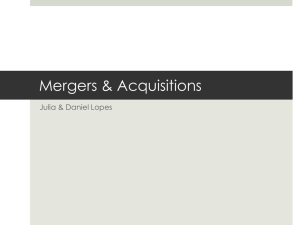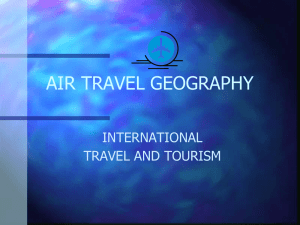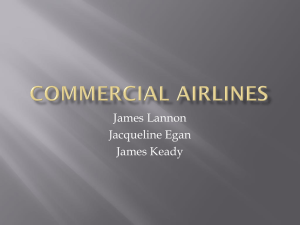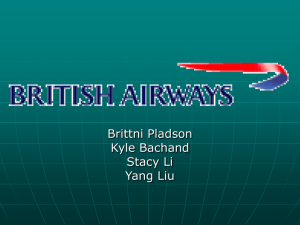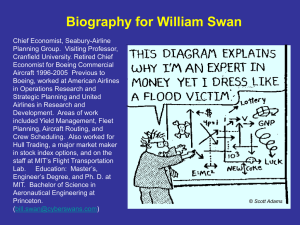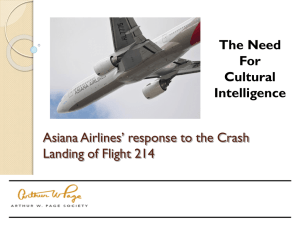Case-03-01-Canadian_Airlines
advertisement
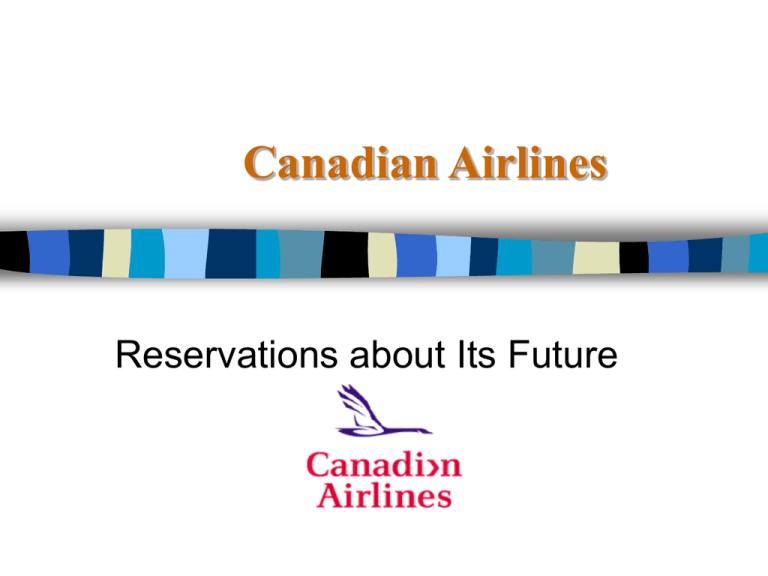
Canadian Airlines Reservations about Its Future Suggested Study Questions 1. What is Canada’s position in the airline industry? 2. What are core IT issues facing the two airlines? 3. How important is a good reservation system? 4. Do you agree with the Ottawa court? Why Choose the Canadian Airlines Case? No industry has provided so clear and public an example of evolving strategic use of IT as the international airline industry. FIVE COMPETITIVE FORCES MODEL NEW MARKET ENTRANTS THE FIRM SUPPLIERS SUBSTITUTE PRODUCTS & SERVICES Threats TRADITIONAL COMPETITORS Bargaining power CUSTOMERS N A. How important is the reservation system to the airline industry and what is its impact to shape competition? (Appendix for its pre-background) Frontier had to fight to have their flights displayed on the UA reservation system. Only legal action allowed them to prevail. The denial of the co-host status meant on Frontier’s connections were not included in the system. Monopoly prices are charged by UA to Frontier. Screen bias problems exist where Frontier flights are displayed less favorably than US. Frontier Case (cont.) UA has instant insight on loading data on Frontier flights, which travel agents will favor Frontier, etc. Ninety-five percent rule forces travel agents to use a single reservation system so the screen bias in Apollo would be widely effective. Special value added features like printing boarding passes only work for UA flights. UA controls and delays the timing of communicating Frontier fares to travel agents. UA incorrectly signals that Frontier flights are sold out when in fact they are not. B. Discuss potential problems of Electronic Commerce and why disinterested information providers have a real advantage. The following factors softened the impact on using CRS (res) as weapons: – public pressure – competition from other reservations systems – threat of law suits It is too costly to develop its own system and to include global flight data. AA has a $150 million a year profit from selling SABRE services to its customers. C. Discuss the current state of play in the Canadian Airline industry. 1. What is Canada’s position in the airline industry? 2. What are core IT issues facing the two airlines? 3. How important is a good reservation system? 4. Do you agree with the Ottawa court? Airlines Organization Chart and their Airline Reservation Systems (CRS/res) Gemini PWA Canadian Air Air Canada Covia AMR UA AA APOLLO SABRE 1. What is Canada’s position in the airline industry? It handles only 2% of the world’s passengers. It is an East/West airline with perhaps 12 profitable cities in the southern part of Canada. It faces intense U.S.A. competition where U.S.A. airlines have a huge advantage because of their hubs where they can, for example, easily transfer somebody from Calgary to San Francisco while staying on the same airline. The Canadian Airline obviously do not have this connection facility. What is Canada’s position in the airline industry? (Cont.) The industry has shrunk from 7 airlines (1985) to 2 airlines. By 1992 both were under extreme profit pressures with Canadian Airlines having lost more than a billion dollars in the last three years. Their financial viability was genuinely in doubt. Canadian authorities’ key objective is to preserve competition inside Canada and, therefore, want two Canadian airlines to exist. It is clear, however, that this competition needs not exist on international routes where, in fact, the two airlines do not compete. 2. What are core IT issues facing the two airlines? Two major players SABRE – 109 global terminals handling 60,000 transactions per day – achieve 50% market share in Toronto and much less in the rest of the country – has not evolved to handle bilingual interactions, i.e., English and French Gemini – uses United Airlines’ Apollo software – operates largest private telecommunications network in Canada and employs 700 people – co-owned by Canadian Airlines and Air Canada Therefore, it represents a formidable barrier to American’s expansion inside Canada. In order to get significant revenue growth out of Canada, American Airlines needs to find a way to disarm Gemini. Canadian Airlines Specific Situations: Employees fearing for the very survival of the airline and thus, their jobs, are willing to give significant wage concessions. Gemini, fearing for its very survival, doesn’t want to surrender Canadian Air to American Air Reasonably aggressively price, moving from Gemini to SABRE, would save Canadian Air $25 million per year Merger with Air Canada is not a possibility because of the Federal Government The Bottom is ... Canadian Air wanting to survive, would be happy to sign a favorable contract to American Airlines combined with the significant American cash infusion and an employee wage cut. Air Canada, neutralized by the government, can do nothing but swallow hard and maintain their relationship with Gemini. The real losers in all of this, of course, are – the staff at Gemini who must operate under a small scope FIVE COMPETITIVE FORCES MODEL NEW MARKET ENTRANTS THE FIRM SUPPLIERS SUBSTITUTE PRODUCTS & SERVICES Threats TRADITIONAL COMPETITORS Bargaining power CUSTOMERS N 3. How important is a good reservation system? Outsourcing vs. strategic weapon – – – – – – – – Competition (competitor) vs. cooperation (partner) airlines reservation system crew scheduling hotel reservation system car rental restaurant shopping its internal IS such as accounting, data processing, communication services, operations planning, pricing, and management capability – and more ... 4. Do you agree with the Ottawa court? YES/ NO Conclusions The competition between AA and UA is very helpful in keeping the worst of the Frontier abuses from happening in Canada. This is a different kind of outsourcing case where two mid-sized firms have completely given up the capacity to innovate through systems. As opposed to the Internet and the world of Emarkets, this is an intriguing case about how AA and UA starting with their own international reservations, have now turned them into major profit centers which in reality need not be associated with their founding airlines. Conclusions (cont.) Canadian spends $20-$25 million less to run its business now that AMR will be handling its IT. Savings from the services were not the driving force behind the deal, explained a spokesman for PWA, “We are able to ride on American’s coat tails in development.” From AA perspective, the deal allowed American to expand into the information services market; for Canadian, it was a question of survival. The deal has ensured its future at least for the next two or three years. Worldwide Airlines Reservation Systems and Foretelling Gemini’s Future Galileo Intl. Galileo PWA AA expects to receive about C$120 million annually for the duration of 20 year contract Gemini Air Canada Canadian Air Canadian Air receives C$246 million through the AMR deal plus other services Covia AMR UA AA APOLLO SABRE Turbulence in the Domestic Market Jean-Jacques Bourgeault, Air Canada’s COO: – “air Canada’s position remains that Canada should have only one flag carrier abroad, but two competing domestic airlines.” – “The merger option is not off. We haven’t given up. Anyone who knows about the airline industry - unless you’re an executive at Canadian or a politician, tends to agree that there is no room for two international airlines in this country. Even if the AMR-PWA deal works out, eventually we’ll be back to tackling the problem. When” In two years? In three.? In five.? As long as Canada remains Canada, there’s one airline too many and we’re going to keep fighting until one of us loses, and I don’t think that’s (going to be) Air Canada.

